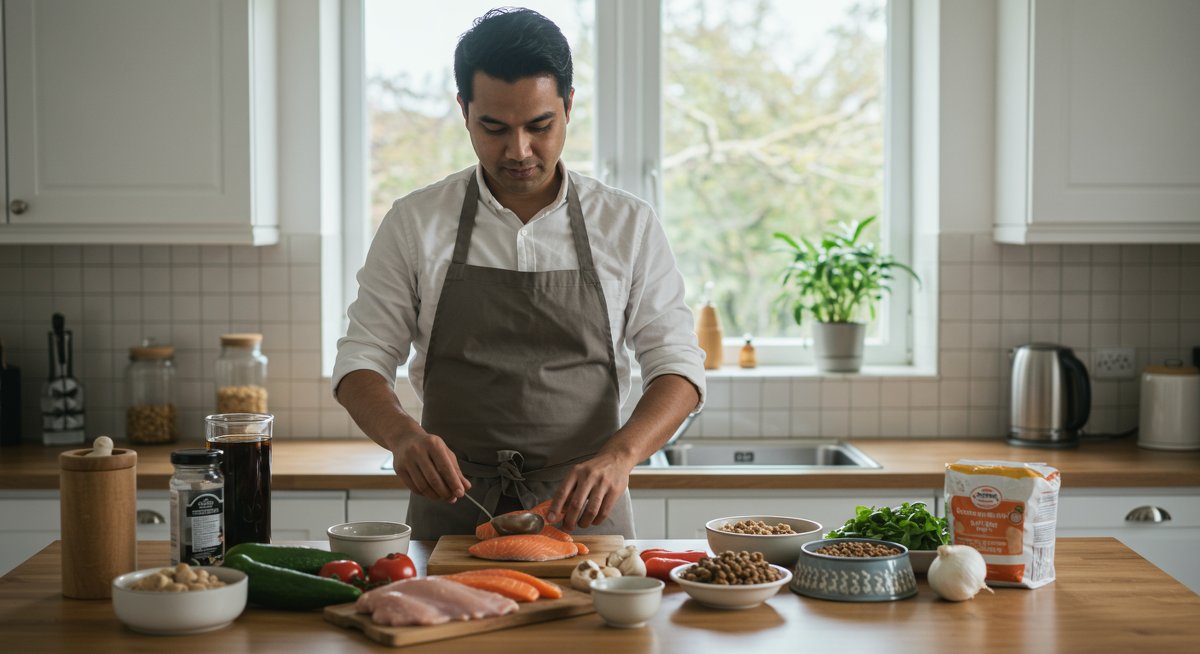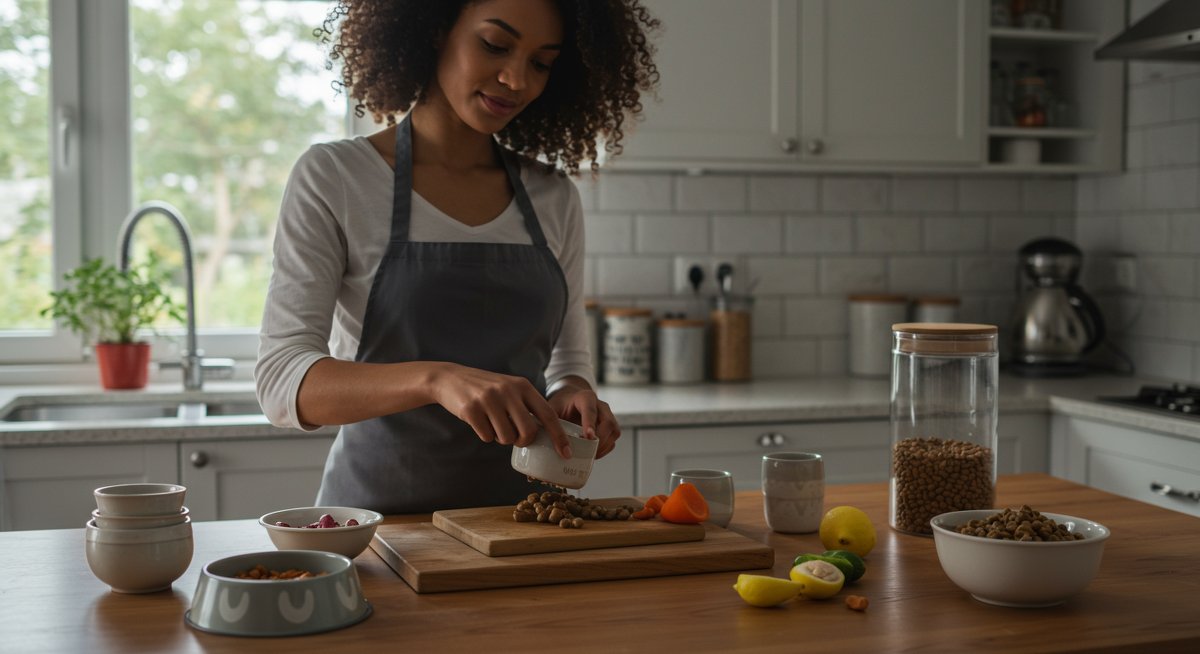Bringing a new cat into your home is a joyous occasion, and you're likely focused on providing the best possible care. One of the most important aspects of feline well-being is their diet. While commercial cat food is convenient, crafting homemade meals offers a personalized approach to your cat's nutrition. This guide will walk you through the benefits of homemade cat food, provide recipes, and offer tips to ensure your cat thrives on a balanced and delicious diet.

Why understanding homemade cat food is crucial for your new pet
Understanding the nutritional needs of your cat is the cornerstone of their health and happiness. Cats are obligate carnivores, meaning their bodies are designed to thrive on a diet primarily composed of animal protein. Homemade cat food allows you to control the ingredients, ensuring your cat receives a diet free from unnecessary fillers, artificial preservatives, and potentially allergenic ingredients often found in commercial brands. By making your own cat food, you can tailor the meals to your cat's specific needs, whether they have allergies, sensitivities, or require a weight management plan. This level of control can lead to improved digestion, a shinier coat, increased energy levels, and a stronger bond with your feline friend.
Essential first steps for cat care
Before diving into recipes, it's essential to understand the basics of feline nutrition. Cats require a high-protein, moderate-fat, and low-carbohydrate diet. Protein sources should come from lean meats like chicken, turkey, and fish. Healthy fats can be sourced from animal fats or supplements like fish oil (in moderation). Carbohydrates should be kept to a minimum, often coming from vegetables like cooked sweet potatoes or green beans, which provide essential vitamins and fiber. Water is also crucial; fresh water should always be available. Consult your veterinarian before making any significant dietary changes, especially if your cat has underlying health conditions. They can help you determine the correct portion sizes and identify any potential nutritional deficiencies.
Common challenges & how to overcome them
Transitioning to homemade cat food can seem daunting, but several challenges are easily overcome. First, ensuring a balanced diet requires understanding your cat's nutritional requirements. Consulting with your veterinarian is vital here, to ensure you're meeting all of their needs. Second, sourcing high-quality ingredients can be more expensive than buying commercial food. However, you can offset these costs by buying in bulk or using coupons. Finally, finding the time to prepare meals can be a hurdle. Meal prepping and freezing portions can streamline the process, making it manageable even for busy pet parents. One key is to start slow, gradually introducing the homemade food to avoid upsetting their digestive system.
Tips for success
Success with homemade cat food hinges on a few key practices. First, always consult with your veterinarian or a certified pet nutritionist to ensure the recipes are nutritionally complete. Second, use high-quality, human-grade ingredients. This means choosing lean meats, fresh vegetables, and avoiding processed foods. Third, introduce the new food gradually, mixing it with your cat's current food over several days to prevent digestive upset. Fourth, monitor your cat's weight and body condition. Adjust portion sizes as needed to maintain a healthy weight. Finally, vary the recipes to prevent boredom and ensure your cat receives a range of nutrients.
Example 1: Begin with a simple recipe like cooked chicken, sweet potatoes, and a small amount of fish oil. Gradually increase the proportion of homemade food in your cat's diet while monitoring their stool consistency and overall energy levels. If they experience digestive upset, slow down the transition. A healthy cat should show interest in the homemade food, and their coat should become shinier within a few weeks.
Example 2: Use a food scale to measure all ingredients precisely. This will ensure that your cat gets the correct amount of each nutrient. For instance, if a recipe calls for 4 ounces of cooked chicken, weigh it out using a food scale. For portion control, measure out individual servings and store them in the refrigerator or freezer. Precise measurements are critical for balancing the diet.
Example 3: To avoid boredom, rotate between several recipes. Incorporate different protein sources (turkey, fish, or even small amounts of cooked organ meats) and vegetables. Consider adding supplements like taurine or a cat-specific multivitamin to ensure they receive all necessary nutrients. Make the meal times fun by using puzzle feeders or hiding the food to encourage natural hunting behaviors.
Building a strong bond with your cat
Preparing homemade meals can strengthen the bond between you and your cat. The process of selecting fresh ingredients, cooking, and serving the food shows your cat that you care about their well-being. Moreover, cats are often more excited about homemade food, viewing mealtimes as a special and interactive experience. This can lead to increased trust and affection. By investing the time and effort into their meals, you're providing more than just sustenance; you're also providing a way to show your cat love and care.

Recommended products for new owners
When starting to make homemade cat food, several tools can make the process easier and more efficient.
- Food Scale: A digital food scale is essential for accurately measuring ingredients. This helps ensure you're following recipes correctly and providing the right portions for your cat. Look for a scale that can measure in both ounces and grams for precision. A highly-rated and reliable option is the OXO Good Grips Stainless Steel Food Scale. The referral URL is not available, so no link will be inserted.
- Pet-Safe Cooking Utensils: Use stainless steel pots, pans, and utensils. Avoid non-stick cookware, which can release harmful fumes.
- Storage Containers: Invest in airtight containers for storing the prepared food in the refrigerator or freezer. This will help maintain freshness and prevent freezer burn.
- Food Processor or Blender: A food processor or blender can make it easier to chop and mix ingredients to the right consistency for your cat.
- Measuring Cups and Spoons: Having a set of measuring cups and spoons is crucial for accurate ingredient measurements.
- Slow Feeder Bowls: These are great for slowing down your cat's eating and preventing them from eating too quickly. This can help with digestion.
Quick troubleshooting guide
Here's a quick guide to address common issues when switching to homemade cat food:
- Digestive Upset: If your cat experiences diarrhea or vomiting, slow down the transition by adding more of their old food to the mix. If the problem persists, consult your veterinarian.
- Pickiness: Some cats are picky eaters. Try warming the food slightly to enhance its aroma. If your cat still refuses to eat, try adding a small amount of a favorite treat, such as cooked chicken or tuna.
- Constipation: Increase the amount of water in their diet (you can mix it with the food) or add fiber-rich vegetables like pumpkin. Consult your vet if it persists.
- Lack of Energy: If your cat seems less energetic, ensure they're eating enough and that the diet is balanced. If the problem continues, consult your vet for a check-up.
Next steps in your pet parenthood journey
Making homemade cat food is a rewarding experience that can significantly enhance your cat's health and well-being. By starting with the basics, gradually introducing new recipes, and staying informed, you can create a diet that supports a long, happy, and healthy life for your feline companion. The next step is to consult with your veterinarian to tailor the diet to your specific cat's needs. Consider joining online forums or communities for homemade cat food enthusiasts to share recipes, tips, and experiences. Continue learning about feline nutrition and always prioritize your cat's health and happiness. Remember, every cat is unique, so be patient and adapt as needed to find the perfect homemade diet for your furry friend.